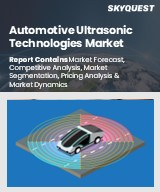
자동차용 초음파 기술 세계 시장 규모는 2023년 56억 9,000만 달러로 평가되었습니다. 예측 기간(2025-2032년) CAGR은 6.9%로, 2024년 60억 8,000만 달러에서 2032년에는 103억 7,000만 달러로 성장할 전망입니다.
세계 자동차용 초음파 기술 시장은 주로 주차 보조, 충돌 방지 등 첨단운전자보조시스템(ADAS)를 강화하기 위해 자동차에 초음파 센서의 도입이 증가하고 있는 것이 큰 성장을 가져오고 있습니다. 자동차 산업이 반자율주행차와 완전자율주행차로 전환함에 따라 효율적이고 비용 효율적인 센싱 기술에 대한 수요가 증가하고 있습니다. 초음파 센서는 특히 저속 주행 시 근거리 감지에 탁월합니다. 안전 규제가 점점 더 엄격해짐에 따라 제조업체들은 안전 강화에 대한 소비자의 기대에 부응하기 위해 이러한 시스템을 ADAS 제품에 통합하고 있습니다. 또한, 도시화, 전기차와 커넥티드카의 급증, 센서의 소형화, 날씨 성능, 대체 기술과의 경쟁 등의 과제에 직면하면서도 다양한 차종에 대한 적용이 더욱 확대되고 있습니다.
Global Automotive Ultrasonic Technologies Market size was valued at USD 5.69 billion in 2023 and is poised to grow from USD 6.08 billion in 2024 to USD 10.37 billion by 2032, growing at a CAGR of 6.9% during the forecast period (2025-2032).
The global automotive ultrasonic technologies market is experiencing significant growth, primarily fueled by the rising implementation of ultrasonic sensors in vehicles to enhance advanced driver assistance systems (ADAS), including parking assistance and collision avoidance. As the automotive industry moves towards semi-autonomous and fully autonomous vehicles, there is a heightened demand for efficient, cost-effective sensing technologies. Ultrasonic sensors excel in short-range detection, particularly during low-speed driving scenarios. With increasingly stringent safety regulations, manufacturers are integrating these systems into ADAS offerings to meet consumer expectations for enhanced safety. Moreover, urbanization, the surge in electric and connected vehicles, and advancements in sensor miniaturization further broaden their application across a range of vehicle types, despite facing challenges like weather performance and competition from alternative technologies.
Top-down and bottom-up approaches were used to estimate and validate the size of the Global Automotive Ultrasonic Technologies market and to estimate the size of various other dependent submarkets. The research methodology used to estimate the market size includes the following details: The key players in the market were identified through secondary research, and their market shares in the respective regions were determined through primary and secondary research. This entire procedure includes the study of the annual and financial reports of the top market players and extensive interviews for key insights from industry leaders such as CEOs, VPs, directors, and marketing executives. All percentage shares split, and breakdowns were determined using secondary sources and verified through Primary sources. All possible parameters that affect the markets covered in this research study have been accounted for, viewed in extensive detail, verified through primary research, and analyzed to get the final quantitative and qualitative data.
Global Automotive Ultrasonic Technologies Market Segments Analysis
Global Automotive Ultrasonic Technologies Market is segmented by Type, Frequency Range, Application, Vehicle Type and region. Based on Type, the market is segmented into Proximity Detection and Range Measurement. Based on Frequency Range, the market is segmented into Low Frequency (20 kHz - 50 kHz), Medium Frequency (50 kHz - 150 kHz), High Frequency (150 kHz - 250 kHz) and Very High Frequency (250 kHz - 1000 kHz). Based on Application, the market is segmented into Parking Sensors, Blind Spot Detection, Adaptive Cruise Control, Lane Keeping Assist, Self-Driving Cars and Others. Based on Vehicle Type, the market is segmented into Passenger Cars, Commercial Vehicles and Two Wheelers. Based on region, the market is segmented into North America, Europe, Asia Pacific, Latin America and Middle East & Africa.
Driver of the Global Automotive Ultrasonic Technologies Market
The Global Automotive Ultrasonic Technologies market is experiencing significant growth driven by the increasing integration of Advanced Driver Assistance Systems (ADAS) in new vehicles. With a majority of vehicles incorporating features such as parking assistance, blind spot detection, and rear cross traffic alerts-all of which utilize ultrasonic sensing-automakers are compelled to adopt these technologies. As safety regulations become more stringent across various regions, manufacturers are standardizing ultrasonic modules even in entry-level and mid-range vehicles. This heightened emphasis on safety, coupled with the efforts of major automotive players to enhance sensor capabilities across both internal combustion and electric vehicle platforms, fuels a consistent demand for compact, cost-effective, and reliable ultrasonic sensors in the market.
Restraints in the Global Automotive Ultrasonic Technologies Market
The Global Automotive Ultrasonic Technologies market faces significant challenges due to the inherent limitations of ultrasonic sensors, particularly their vulnerability to performance issues in adverse weather conditions like heavy rain, snow, and fog. Environmental factors such as water droplets, reflective surfaces, and nearby dense materials can lead to inaccuracies, including false positives and detection gaps. As manufacturers work towards achieving fully autonomous vehicles, the dependency on ultrasonic sensors for crucial operational decisions becomes constrained. Consequently, many automakers are shifting their focus towards LiDAR and radar systems as supplementary options, which may reduce the market's growth potential for standalone ultrasonic technology.
Market Trends of the Global Automotive Ultrasonic Technologies Market
The integration of digital twin technology in the Global Automotive Ultrasonic Technologies market is significantly transforming sensor development and calibration practices. This trend sees manufacturers leveraging cloud-based models to accurately simulate the performance of ultrasonic sensors under various driving scenarios, enhancing their role in advanced driver assistance systems (ADAS). By utilizing digital twins, companies can refine sensor placements, minimize calibration issues, and proactively monitor sensor reliability, ultimately enhancing safety and efficiency. The adoption of such technology significantly boosts the rate of iteration, leading to improved accuracy in detection and reduced false positives, thereby revolutionizing the ultrasonic sensor landscape in automotive applications.